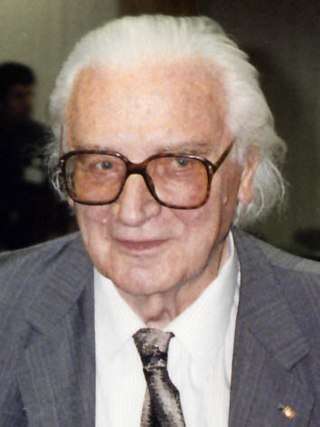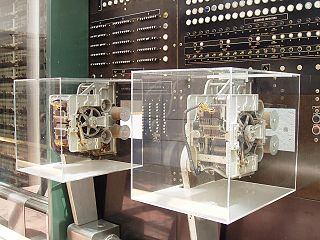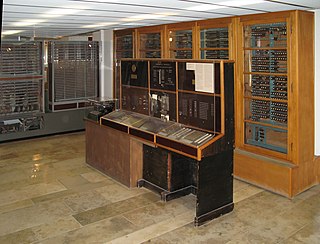
The Atanasoff–Berry computer (ABC) was the first automatic electronic digital computer. Limited by the technology of the day, and execution, the device has remained somewhat obscure. The ABC's priority is debated among historians of computer technology, because it was neither programmable, nor Turing-complete. Conventionally, the ABC would be considered the first electronic ALU – which is integrated into every modern processor's design.
The bit is the most basic unit of information in computing and digital communications. The name is a portmanteau of binary digit. The bit represents a logical state with one of two possible values. These values are most commonly represented as either "1" or "0", but other representations such as true/false, yes/no, on/off, or +/− are also widely used.

The history of computing hardware covers the developments from early simple devices to aid calculation to modern day computers.

Konrad Ernst Otto Zuse was a German civil engineer, pioneering computer scientist, inventor and businessman. His greatest achievement was the world's first programmable computer; the functional program-controlled Turing-complete Z3 became operational in May 1941. Thanks to this machine and its predecessors, Zuse is regarded by some as the inventor and father of the modern computer.
In computer jargon, a killer poke is a method of inducing physical hardware damage on a machine or its peripherals by the insertion of invalid values, via, for example, BASIC's POKE command, into a memory-mapped control register. The term is typically used to describe a family of fairly well known tricks that can overload the analog electronics in the CRT monitors of computers lacking hardware sanity checking
Reverse Polish notation (RPN), also known as reverse Łukasiewicz notation, Polish postfix notation or simply postfix notation, is a mathematical notation in which operators follow their operands, in contrast to prefix or Polish notation (PN), in which operators precede their operands. The notation does not need any parentheses for as long as each operator has a fixed number of operands.
In computability theory, a system of data-manipulation rules is said to be Turing-complete or computationally universal if it can be used to simulate any Turing machine. This means that this system is able to recognize or decide other data-manipulation rule sets. Turing completeness is used as a way to express the power of such a data-manipulation rule set. Virtually all programming languages today are Turing-complete.
Plankalkül is a programming language designed for engineering purposes by Konrad Zuse between 1942 and 1945. It was the first high-level programming language to be designed for a computer.

The Z3 was a German electromechanical computer designed by Konrad Zuse in 1938, and completed in 1941. It was the world's first working programmable, fully automatic digital computer. The Z3 was built with 2,600 relays, implementing a 22-bit word length that operated at a clock frequency of about 5–10 Hz. Program code was stored on punched film. Initial values were entered manually.

The Harvard Mark I, or IBM Automatic Sequence Controlled Calculator (ASCC), was one of the earliest general-purpose electromechanical computers used in the war effort during the last part of World War II.
In computer engineering, Halt and Catch Fire, known by the assembly language mnemonic HCF, is an idiom referring to a computer machine code instruction that causes the computer's central processing unit (CPU) to cease meaningful operation, typically requiring a restart of the computer. It originally referred to a fictitious instruction in IBM System/360 computers, making a joke about its numerous non-obvious instruction mnemonics.

The Manchester Baby, also called the Small-Scale Experimental Machine (SSEM), was the first electronic stored-program computer. It was built at the University of Manchester by Frederic C. Williams, Tom Kilburn, and Geoff Tootill, and ran its first program on 21 June 1948.

The Z4 was arguably the world's first commercial digital computer, and is the oldest surviving programmable computer. It was designed, and manufactured by early computer scientist Konrad Zuse's company Zuse Apparatebau, for an order placed by Henschel & Son, in 1942; though only partially assembled in Berlin, then completed in Göttingen, and not delivered before the defeat of Nazi Germany, in 1945. The Z4 was Zuse's final target for the Z3 design. Like the earlier Z2, it comprised a combination of mechanical memory and electromechanical logic, so was not a true electronic computer.

The Z22 was the seventh computer model Konrad Zuse developed. One of the early commercial computers, the Z22's design was finished about 1955. The major version jump from Z11 to Z22 was due to the use of vacuum tubes, as opposed to the electromechanical systems used in earlier models. The first machines built were shipped to Berlin and Aachen.

The Z2 was an electromechanical digital computer that was completed by Konrad Zuse in 1940. It was an improvement on the Z1 Zuse built in his parents' home, which used the same mechanical memory. In the Z2, he replaced the arithmetic and control logic with 600 electrical relay circuits, weighing over 600 pounds.

The history of computer science began long before the modern discipline of computer science, usually appearing in forms like mathematics or physics. Developments in previous centuries alluded to the discipline that we now know as computer science. This progression, from mechanical inventions and mathematical theories towards modern computer concepts and machines, led to the development of a major academic field, massive technological advancement across the Western world, and the basis of a massive worldwide trade and culture.

A computer is a machine that can be programmed to carry out sequences of arithmetic or logical operations (computation) automatically. Modern digital electronic computers can perform generic sets of operations known as programs. These programs enable computers to perform a wide range of tasks. The term computer system may refer to a nominally complete computer that includes the hardware, operating system, software, and peripheral equipment needed and used for full operation; or to a group of computers that are linked and function together, such as a computer network or computer cluster.
Helmut Theodor Schreyer was a German inventor. He is mostly known for his work on the Z3, the world's first programmable computer.
The Z5 was a computer designed by Konrad Zuse and manufactured by Zuse KG following an order by Ernst Leitz GmbH in Wetzlar in 1950. The computer was delivered in July 1953 and was the first commercial built-to-order mainframe in Germany. The computer was purchased to help with the design of optical lens systems.

The ERMETH (Electronic Calculating Machine of the ETH) was one of the first computers in Europe and was developed and built by Eduard Stiefel and his team of the Institute for Applied Mathematics at the ETH Zurich between 1948 and 1956. It was in use until 1963 and is now displayed at the Museum of Communication Bern (Switzerland).
















